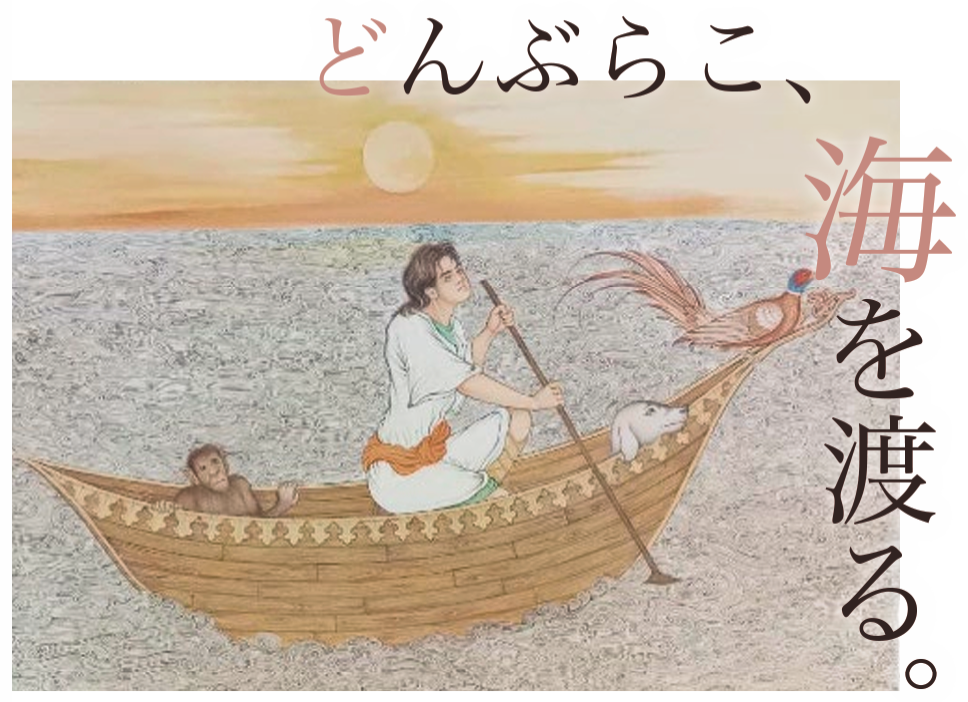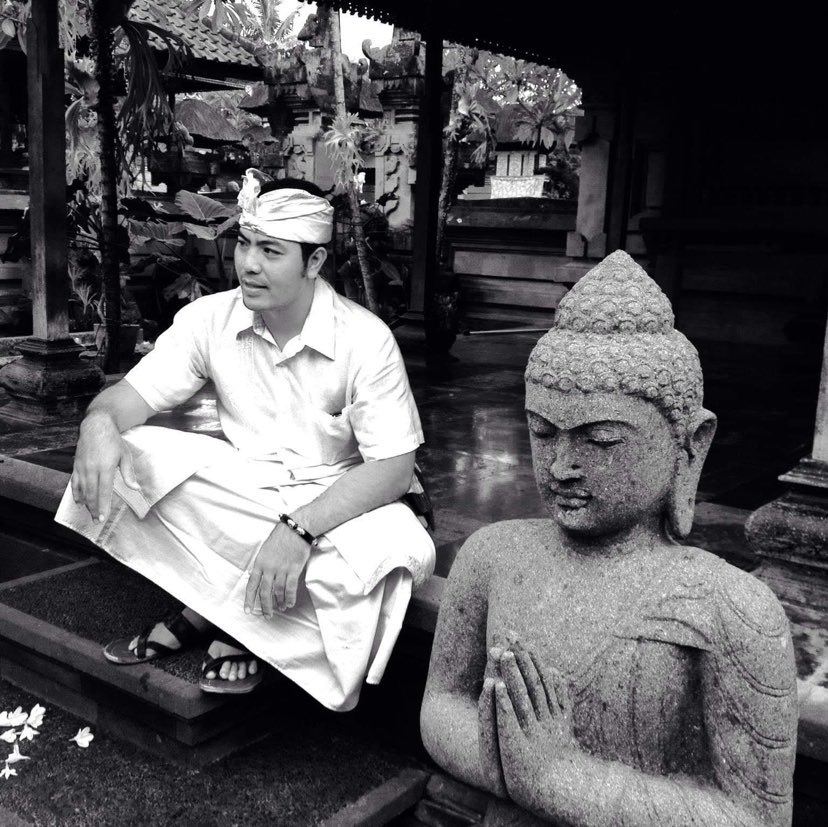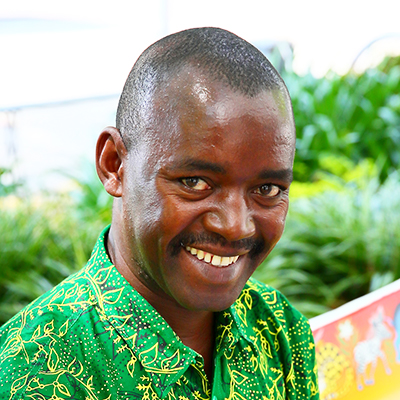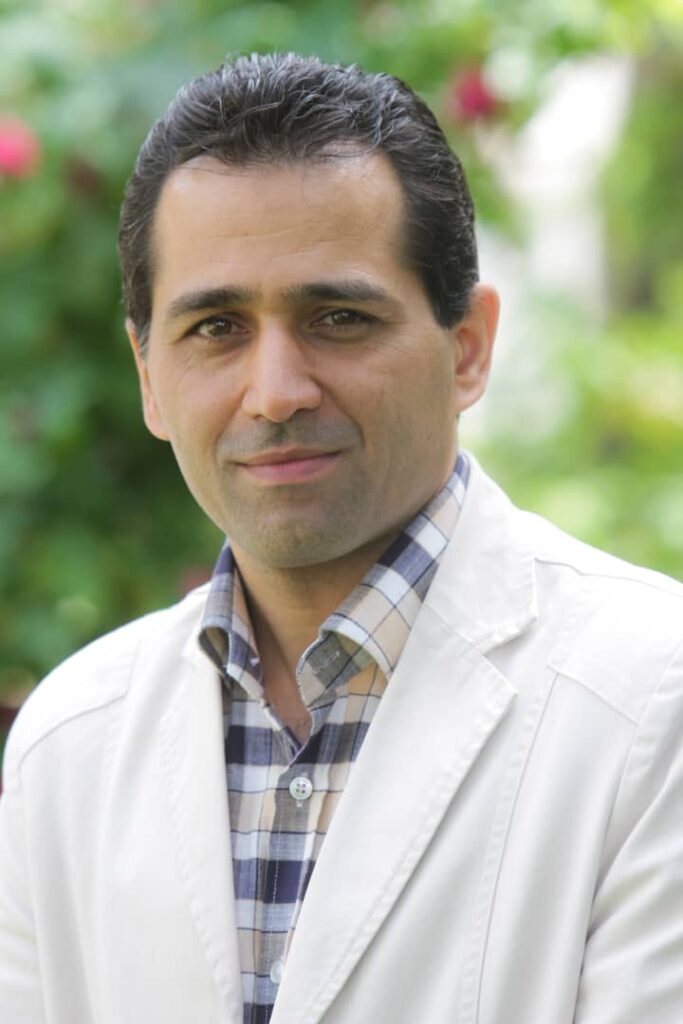
Welcome to the "Momotaro Around the World: Domburako, Crossing the Sea" exhibition.
Momotaro project is to translate Momotaro, a Japanese folktale, into English, Indonesian, and Persian and to have traditional painters from the three countries draw illustrations. We started this project in July 2022 with the idea that if Momotaro, a story known to everyone in Japan, were painted by foreign artists who had no background knowledge of the story, we could create a variety of Momotaro that would reflect the character and regional characteristics of each country. At the launch, we had no contact with traditional painters. Still, with the support of various people, all the paintings were completed one year later, in July 2023. For this exhibition, we set the theme of Momotaro, a traditional Japanese fairy tale with international connections. We aimed to create a place where people could exchange their hearts and minds by creating paintings in which the story of one country is told in accordance with the traditions of another.
Information
Session
Kyoto: December 13, 2023 - December 17, 2023
Okayama: January 16, 2024 - January 21, 2024
Fukuyama: March 19, 2024-March 21, 2024
Tokyo: April 21, 2024-April 27, 2024
Time
10:00~18:00
※16:00 on the last day only
Venue
Kyoto: Kyoto Culture Museum (〒604-8183 Sanjo Takakura, Nakagyo-ku, Kyoto City, Kyoto)
Okayama: Okayama Tenjinyama Cultural Plaza (8-54 Tenjinmachi, Kita-ku, Okayama City, Okayama 700-0814, Japan)
Fukuyama: Fukujyukaikan (2nd Floor Fukujyukaikan,9-8-1, Marunouchi, Fukuyama City, Hiroshima 720-0061, Japan)
Tokyo: Gallery Seira (1st Floor Bijyutsukaikan, 19-10-3, Ginza, Chuo-ku, Tokyo, 104-0061, Japan)
Admission fee
500 yen
*For the Tokyo venue, we ask for a donation of about 500 yen.
Organizer
Culpedia
About the Organizing Organization
Culpedia started its activities in 2020 as an organization that bets on the potential of a common language called culture to overcome the boundaries and barriers that stand between people, such as countries and regions (horizontally) and eras and generations (vertically), and to realize peace in human society. The organization was formed by a group of working adults and students with the desire to become an encyclopedia of culture by connecting the English words "Culture" and "Pedia," which means "encyclopedia. The organization's core activities are to pass on to the next generation the culture that is dying out not only in Japan but worldwide and to promote cultural exchange across national borders. We are working daily to realize a society in which "Japan bears the world's culture and Japanese culture bears the world's culture" and to contribute to world peace, even if only a little.
Sponsorship
E.P.I Co., Ltd. , KOEIDO CO.,LTD
Support and Cooperation
Okayama Prefecture , Okayama City , Kyoto City
Artist Profile
Indonesia
Name
I Made GRIYAWAN
Biography
Born 1979 in Batuan village, Bali, Indonesia, he started painting at 7 with his father (I Wayan TAWENG), an artist. From 2012 onwards, he has participated in many national and international exhibitions. Since 2012, he has participated in many local and international exhibitions, including the Batuan Museum (Batuan, Bali) (2012), Alma Museum (Ubud, Bali) (2012), Puri Lukisan Museum (Ubud, Bali) (2013), Jakarta UOB (United Overseas Bank) Art Contest (2014), and the Art Contest in New York and the Embassy of Indonesia in Washington D.C. (2015), Tokyo International Art Fair (2016), etc.
What is Batuan Painting?
Batuan painting is a type of Balinese painting that refers to paintings made in the village of Batuan in central Bali. The last recorded reference to painting dates back to an imperial decree in 1022 when artists continued to create paintings to be presented to the court of the local Gianyar kingdom. The painting culture has remained in different forms since then. Still, especially in the 1930s, artists in the village began to develop their style under the influence of the Dutch culture, which was the suzerain state at that time. In the Batuan painting style, dark colors are emphasized, with black and white as the base colors and rock paints added to give the overall impression of profundity.
Tanzania
Name
Abdalla Saidi Chilanboni
Biography
Born in 1968 in Nakapayana, Tanzania, he moved to Dar es Salaam at age 20 to work as an auto mechanic before becoming a tinga tinga artist in 1989 under his uncle Saidi. In 2017, "African Folktales: Shiawase no Naru Ki (The Tree of Happiness)" was published by Miraisha, with illustrations by Yumiko Shimaoka and pictures by Yafidou Makaka and eight other Tingatinga artists. Yafidou Makaka and 8 Tingatinga Artists).
What is Tingatinga Art?
Tingatinga art is a style of painting that emerged at the end of the 1960s, just after Tanzania's independence and is a contemporary art form that uses six colors of paint to vividly depict the animals, rich nature, and people's lives in the savanna. The founder, Mr. Tingatinga, was concerned that most paintings tourists bought as souvenirs at the time were painted in the Congo. He created art in Tanzania, painting natural scenes of Tanzanian wildlife and plants.
Iran
Name
Amir Hosein Aghamiri
略歴
He was born in Tehran in 1971. He graduated from the Department of Painting at the University of Sur. Participated in more than 50 domestic and international exhibitions, including the Iranian Painting Biennale in Tehran (1995, 1999, 2001, 2005, 2007) and the International Quran Exhibition (2002, 2003, 2004). , 2005). She won the 3rd Fajr International Festival (2010). Other works include the Dubai Festival (2001), the Iranian-Turkish Joint Miniature Exhibition (2003), the Moscow Iranian Art Exhibition (2004), the Armenia-Iranian Exhibition (2006), and the Pakistan-Iranian Art Exhibition (2012) has exhibited at.
What is Iran Miniature?
Miniature painting, known as small painting, became famous as Persian art in the 13th century. Still, later, with the Mongol conquest, it was gradually influenced by China and reached its peak tradition in the 15th and 16th centuries. This tradition continued with the influence of the West, and painting has continued to evolve until the present day. Persian (Iranian) miniature painting had a dominant force on other Islamic miniature traditions, with similarities mainly in the Ottoman Empire (now Turkey and elsewhere) and the Mughal Empire (now the Indian subcontinent). You can find paintings. It was registered as a UNESCO Intangible Cultural Heritage in 2020.



